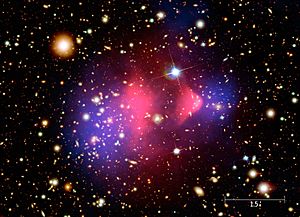Bullet Cluster facts for kids
Quick facts for kids Bullet Cluster |
|
|---|---|
| Bullet cluster.jpg
X-ray photo by Chandra X-ray Observatory. Exposure time was 140 hours. The scale is shown in megaparsecs. Redshift (z) = 0.3, meaning its light has wavelengths stretched by a factor of 1.3.
|
|
| Observation data (Epoch J2000) | |
| Constellation(s) | Carina |
| Right ascension | 06h 58m 37.9s |
| Declination | -55° 57′ 0″ |
| Number of galaxies | ~40 |
| Redshift | 0.296 |
| Distance (co-moving) |
1.141 Gpc (3.7 billion light-years). |
| ICM temperature | 17.4 ± 2.5 keV |
| X-ray luminosity | 1.4 ± 0.3 × 1039 h50−2 joule/s (bolometric) |
| X-ray flux | 5.6 ± 0.6 × 10−19 watt/cm2 (0.1–2.4 keV) |
| Other designations | |
| 1E 0657-56, 1E 0657-558 | |
The Bullet Cluster (also known as 1E 0657-56) is a fascinating place in space. It's made of two huge groups of galaxies that are crashing into each other! When we say "Bullet Cluster," we're usually talking about the smaller group that's zooming away from the bigger one. This amazing cosmic crash is happening about 3.7 billion light-years away from us.
Scientists have studied the Bullet Cluster using something called gravitational lensing. These studies give us some of the strongest clues yet that something called dark matter really exists. Other galaxy collisions, like one called MACS J0025.4-1222, also support the idea of dark matter.
| Top - 0-9 A B C D E F G H I J K L M N O P Q R S T U V W X Y Z |
What is the Bullet Cluster?
The Bullet Cluster is unique because its different parts act differently during the collision. These parts are:
- The stars in the galaxies.
- The hot gas between the galaxies.
- The mysterious dark matter.
Let's look at how each part behaves. The stars in the galaxies mostly passed right through each other. They slowed down a bit due to gravity, but they weren't really changed by the crash. We can see these stars using regular visible light.
The hot gas is different. This gas is what we call "ordinary" matter. It makes up most of the normal stuff in the cluster. We can see this gas glowing brightly in X-rays. When the two gas clouds from each cluster crashed, they bumped into each other. This made them slow down much more than the stars did.
Finding Dark Matter
The third part, dark matter, is very special. We can't see dark matter directly because it doesn't give off light. But we can detect it by how its gravity bends the light from objects behind it. This bending of light is called gravitational lensing.
In theories that don't include dark matter, scientists would expect the gravity to follow the ordinary matter, like the X-ray gas. But when scientists looked at the Bullet Cluster, they found something surprising. The strongest gravity, which causes the lensing, was in two separate areas. These areas were near the visible galaxies, but they were ahead of the hot gas clouds.
This discovery strongly supports the idea of dark matter. It suggests that most of the gravity in the Bullet Cluster comes from two big clumps of dark matter. These dark matter clumps passed through the collision without slowing down much, just like the stars. This is exactly what scientists expect from dark matter, which only interacts through gravity.
The Bullet Cluster is one of the hottest clusters of galaxies ever found. It helps scientists test their ideas about how the universe works. From Earth, it looks like the smaller cluster passed through the center of the main cluster about 150 million years ago. This created a huge, bow-shaped shock wave. This shock wave formed as super-hot gas from the smaller cluster plowed through even hotter gas in the main cluster. It was moving at an incredible speed of almost 10 million kilometers per hour (6 million miles per hour)! The energy released by this shock wave is as much as 10 typical quasars.
Why the Bullet Cluster is Important for Dark Matter
The Bullet Cluster gives us the best evidence so far about what dark matter is like. It also helps rule out some other ideas about gravity, like Modified Newtonian dynamics (MOND), especially for large galaxy clusters.
Scientists found that the center of all the mass in the cluster is not in the same place as the center of the ordinary matter (like the gas). This difference cannot be explained by just changing the laws of gravity. This means there must be something else, like dark matter, causing the extra gravity.
Scientists like Greg Madejski and Eric Hayashi have studied the Bullet Cluster closely. They found that the hot, X-ray-emitting gas lags behind the galaxies. But the dark matter, which they found using gravitational lensing, stays with the galaxies. This shows that the dark matter doesn't bump into other things easily, unlike the gas. This helps scientists understand how dark matter interacts with itself and with normal matter.
Some early studies suggested that the speed of the collision in the Bullet Cluster might not fit with the standard model of the universe (called the Lambda-CDM model). However, newer research has shown that the collision's speed is actually consistent with this model. The earlier confusion came from using smaller simulations and different ways of identifying the colliding clusters.
See also
 In Spanish: Cúmulo Bala para niños
In Spanish: Cúmulo Bala para niños
- Abell 520 – another galaxy cluster where dark and normal matter might have separated during a big crash.
- NGC 1052-DF2
- List of galaxy groups and clusters


